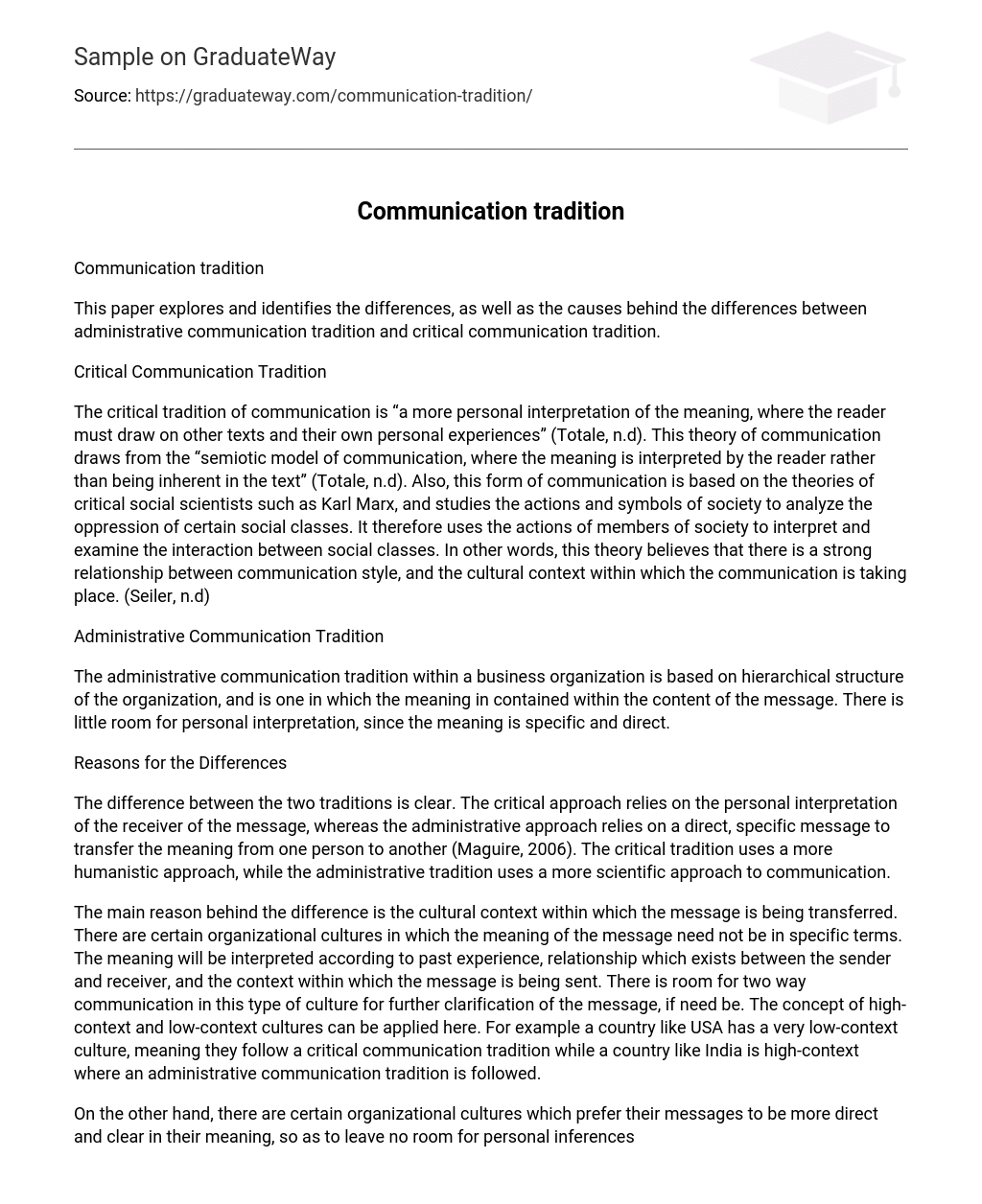This paper explores and identifies the differences between administrative communication tradition and critical communication tradition, as well as the causes behind these differences.
Critical Communication Tradition
The critical tradition of communication is a theory that emphasizes a more personal interpretation of meaning. According to Totale (n.d), readers must draw on other texts and their own experiences to understand the message being conveyed. This approach draws from the semiotic model of communication, which suggests that meaning is not inherent in the text but rather interpreted by the reader.
Furthermore, this theory is based on the work of critical social scientists such as Karl Marx. It examines how symbols and actions within society can be used to analyze oppression among different social classes. Essentially, this theory believes that communication style is closely linked with cultural context (Seiler, n.d).
Administrative Communication Tradition
The administrative communication tradition within a business organization is based on a hierarchical structure. The meaning is contained within the content of the message, leaving little room for personal interpretation. This results in specific and direct communication.
Reasons for the Differences
The difference between the two traditions is clear. The critical approach relies on the personal interpretation of the receiver of the message, whereas the administrative approach relies on a direct and specific message to transfer meaning from one person to another (Maguire, 2006). The critical tradition uses a more humanistic approach, while the administrative tradition uses a more scientific approach to communication.
The main reason behind the difference is the cultural context within which the message is being transferred. Certain organizational cultures do not require specific terms to convey meaning, as it will be interpreted based on past experience, relationship between sender and receiver, and context. In this type of culture, there is room for two-way communication to clarify messages if necessary. The concept of high-context and low-context cultures can be applied here. For example, a country like the USA has a low-context culture that follows critical communication traditions while India has a high-context culture that follows administrative communication traditions.
On the other hand, some organizational cultures prefer direct and clear messages that leave no room for personal interpretation. In these cultures, two-way communication is unnecessary because the meaning is inherently clear and requires no further clarification. For instance, advertisements require a communication style that leans towards a critical approach. The message contains facts but allows the receiver to interpret it according to their opinions and preconceived beliefs. Advertising companies usually have an organizational culture that advocates for this flexibility.
On the other hand, newspapers and research articles should adopt a communication style that leans towards the administrative approach. Their findings must directly inform their audience, leaving little room for interpretation based on past experiences. Another possible reason for the differences between these two traditions is the nature of the message itself. Some messages are more critical than others and require specific orders to be followed; otherwise, there could be grave consequences for the organization. Such messages rely on the administrative tradition because it cannot risk that receivers interpret them in any other way than what was intended by the sender. When messages are not as critical and are sent casually between two members of an organization, they can rely on the critical tradition.
Conclusion.
The main difference between the two traditions can be identified as follows: The critical tradition draws upon the entire societal and cultural context within which the message is being sent. The interpretation of meaning depends on the receiver, who will draw upon their past beliefs and experiences to interpret the message. On the other hand, the administrative tradition relies on a straightforward message in which the meaning is contained within the text or content of the message itself. These differences occur because of variations in high and low context cultures, as well as differences in importance placed on intended messages.
References
Maguire, K. C. (2006). Making Sense of the Seven Communication Traditions.” Communication Teacher, Volume 20, Number 4, October 2006, pp. 89-92.
Seiler, RM. Human Communication in the Critical Theory Tradition.” [Internet]. Available from: http://www.ucalgary.ca/
Totale, JT. presents critical and pragmatic approaches to Media Studies in Australia on http://www.everything2.com/e2node/Critical%20and%20pragmatic%20approaches%20to%20Media %20Studies % 20in % 20Australia. Accessed on 27 October 2008.





